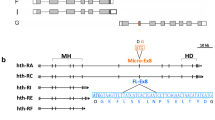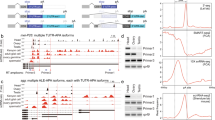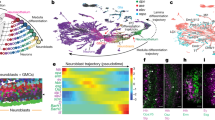Abstract
The Drosophila melanogaster transcription factor Lola (longitudinals lacking) is a pivotal regulator of neural wiring that sets the precise expression levels of proteins that execute specific axon guidance decisions. Lola has a zinc finger DNA binding domain and a BTB (for Broad-complex, Tramtrack and Bric a brac) dimerization motif. We now show that alternative splicing of the lola gene creates a family of 19 transcription factors. All lola isoforms share a common dimerization domain, but 17 have their own unique DNA-binding domains. Seven of these 17 isoforms are present in the distantly-related Dipteran Anopheles gambiae, suggesting that the properties of specific isoforms are likely to be critical to lola function. Analysis of the expression patterns of individual splice variants and of the phenotypes of mutants lacking single isoforms supports this idea and establishes that the alternative forms of lola are responsible for different functions of this gene. Thus, in this system, the alternative splicing of a key transcription factor helps to explain how a small genome encodes all the information that is necessary to specify the enormous diversity of axonal trajectories.
This is a preview of subscription content, access via your institution
Access options
Subscribe to this journal
Receive 12 print issues and online access
$209.00 per year
only $17.42 per issue
Buy this article
- Purchase on Springer Link
- Instant access to full article PDF
Prices may be subject to local taxes which are calculated during checkout








Similar content being viewed by others
References
Black, D.L. Protein diversity from alternative splicing: A challenge for bioinformatics and post-genome biology. Cell 103, 367–370 (2000).
Maniatis, T. & Tasic, B. Alternative pre-mRNA splicing and proteome expansion in metazoans. Nature 418, 236–243 (2002).
Schmucker, D. et al. Drosophila Dscam is an axon guidance receptor exhibiting extraordinary molecular diversity. Cell 101, 671–684 (2000).
Ullrich, B., Ushkaryov, Y.A. & Sudhof, T.C. Cartography of neurexins: more than 1000 isoforms generated by alternative splicing and expressed in distinct subsets of neurons. Neuron 14, 497–507 (1995).
Bayer, C., Holley, B. & Fristrom, J. A switch in broad-complex zinc-finger isoform expression is regulated posttranscriptionally during the metamorphosis of Drosophila imaginal discs. Dev. Biol. 177, 1–14 (1996).
DiBello, P., Wither, D., Bayer, C., Fristrom, J. & Guild, G. The Drosophila Broad-Complex encodes a family of related proteins containing zinc fingers. Genetics 129, 385–397 (1991).
Harrison, S.T. & Travers, A. The tramtrack gene encodes a Drosophila finger protein that interacts with the ftz transcriptional regulatory region and shows a novel embryonic expression pattern. EMBO J. 9 207–216 (1990).
Read, D.M. & Manley, J. Alternatively spliced transcripts of the Drosophila tramtrack gene encode zinc finger proteins with distinct DNA binding specificities. EMBO J. 11, 1035–1044 (1992).
Crowner, D., Madden, K., Goeke, S. & Giniger, E. Lola regulates midline crossing of CNS axons in Drosophila. Development 129, 1317–1325 (2002).
Giniger, E., Tietje, K., Jan, L.Y. & Jan, Y.N. lola encodes a putative transcription factor required for axon growth and guidance in Drosophila. Development 120, 1385–1398 (1994).
Madden, K., Crowner, D. & Giniger, E. lola has the properties of a master regulator of axon–target interactions for SNb motor axons of Drosophila. Dev. Biol. 213, 301–313 (1999).
Seeger, M., Tear, G., Ferres-Marco, D. & Goodman, C.S. Mutations affecting growth cone guidance in Drosophila: genes necessary for guidance towards or away from the midline. Neuron 10, 409–426 (1993).
Collins, T., Stone, J. & Williams, A. All in the family: the BTB/POZ, KRAB, and SCAN domains. Mol. Cell. Biol. 21, 3609–3615 (2001).
Bardwell, V.J. & Treisman, R. The POZ domain: a conserved protein–protein interaction motif. Genes Dev. 8, 1664–1677 (1994).
Huynh, K.D. & Bardwell, V.J. The BCL-6 POZ domain and other POZ domains interact with the co-repressors N-CoR and SMRT. Oncogene 17, 2473–2484 (1998).
Cavarec, L., Jensen, S., Casella, J.F., Cristescu, S.A. & Heidmann, T. Molecular cloning and characterization of a transcription factor for the copia retrotransposon with homology to the BTB-containing Lola neurogenic factor. Mol. Cell. Biol. 17, 482–494 (1997).
Pabo, C.O., Peisach, E. & Grant, R.A. Design and selection of novel Cys2His2 zinc finger proteins. Annu. Rev. Biochem. 70, 313–340 (2001).
Zdobnov, E.M. et al. Comparative genome and proteome analysis of Anopheles gambiae and Drosophila melanogaster. Science 298, 149–159 (2002).
Choo, Y. & Klug, A. A role in DNA binding for the linker sequences of the first three zinc fingers of TFIIIA. Nucl. Acids Res. 21, 3341–3346 (1993).
Liew, C.K. et al. Solution structures of two CCHC zinc fingers from the FOG family protein U-shaped that mediate protein-protein interactions. Structure Fold Des. 8, 1157–1166 (2000).
Laity, J.H., Lee, B.M. & Wright, P.E. Zinc finger proteins: new insights into structural and functional diversity. Curr. Opin. Struct. Biol. 1, 39–46 (2001).
Fairall, L., Schwabe, J.W., Chapman, L., Finch, J.T. & Rhodes, D. The crystal structure of a two zinc-finger peptide reveals an extension to the rules for zinc-finger/DNA recognition. Nature 366, 483–487 (1993).
Appling, D. Genetic approaches to the study of protein–protein interactions. Methods 2, 338–349 (1999).
Cheng, N.N., Sinclair, D.A., Campbell, R.B. & Brock, H.W. Interactions of polyhomeotic with Polycomb group genes of Drosophila melanogaster. Genetics 4, 1151–1162 (1994).
Kidd, T., Bland, K.S. & Goodman, C.S. Slit is the midline repellant for the Robo receptor in Drosophila. Cell 96, 785–794 (1999).
Collins, T., Stone, J. & Williams, A. All in the family: the BTB/POZ, KRAB and SCAN domains. Mol. Cell. Biol. 21, 3609–3615 (2001).
Zheng, W. et al. A developmentally regulated splice variant from the complex lola locus encoding multiple different zinc finger domain proteins interacts with the chromosomal kinase JIL-1. J. Biol. Chem. 278, 11696–11704 (2003).
Ohsako, T., Horiuchi, T., Matsuo, T., Komaya, S. & Aigaki, T. Drosophila lola encodes a family of BTB-transcription regulators with highly variable C-terminal domains containing zinc finger motifs. Gene (in press).
Giniger, E. A role for abl in Notch signaling. Neuron 20, 667–681 (1998).
Lin, D.M. & Goodman, C.S. Ectopic and increased expression of Fasciclin II alters motoneuron growth cone guidance. Neuron 13, 507–523 (1994).
Bailey, T.G., Gribskov, M. Combining evidence using p-values: application to sequence homology searches. Bioinformatics 4, 48–54 (1998).
Rice, P.L. I. and Bleasby, A. EMBOSS: the European Molecular Biology Open Software Suite. Trends Genet. 16, 276–277 (2000).
Acknowledgements
We thank all the members of our lab for advice and assistance during the course of these experiments, and we thank C. Doe for helping us with the interpretation of vNR expression patterns, J. Lengyel for suggesting the comparison to mosquito, and H. Malik for discussion about the phylogenetic analysis. For comments on the manuscript, we thank S. Parkhurst, S. Tapscott, L. Buck and S. Henikoff. This work was supported by National Science Foundation grant IBN-9904519 (E.G.) and by a Grant-in-Aid for Scientific Research on Priority Areas (C) “Genome Science” from the Ministry of Education, Culture, Sports, Science and Technology of Japan (#12202002 to T.A.).
Author information
Authors and Affiliations
Corresponding author
Ethics declarations
Competing interests
The authors declare no competing financial interests.
Supplementary information
Rights and permissions
About this article
Cite this article
Goeke, S., Greene, E., Grant, P. et al. Alternative splicing of lola generates 19 transcription factors controlling axon guidance in Drosophila. Nat Neurosci 6, 917–924 (2003). https://doi.org/10.1038/nn1105
Received:
Accepted:
Published:
Issue Date:
DOI: https://doi.org/10.1038/nn1105
This article is cited by
-
Emergence and influence of sequence bias in evolutionarily malleable, mammalian tandem arrays
BMC Biology (2023)
-
Lola-I is a promoter pioneer factor that establishes de novo Pol II pausing during development
Nature Communications (2023)
-
A dual role of lola in Drosophila ovary development: regulating stem cell niche establishment and repressing apoptosis
Cell Death & Disease (2022)
-
Characterization and potential role of microRNA in the Chinese dominant malaria mosquito Anopheles sinensis (Diptera: Culicidae) throughout four different life stages
Cell & Bioscience (2018)
-
Trans-spliced long non-coding RNA: an emerging regulator of pluripotency
Cellular and Molecular Life Sciences (2018)



